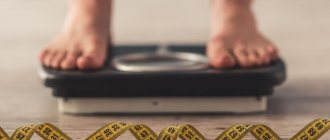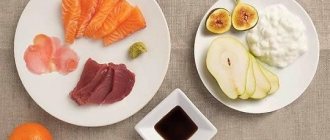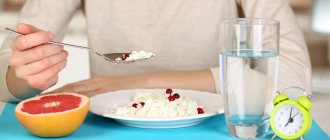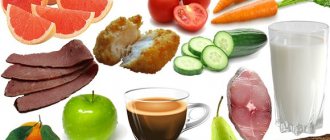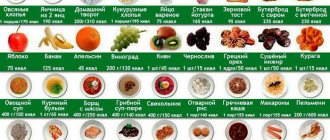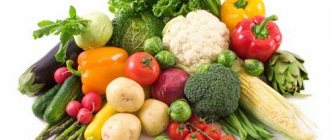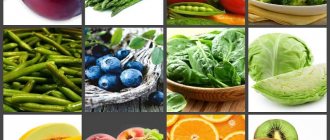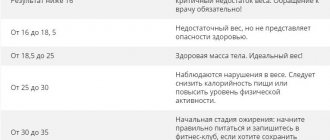Fractional meal plan for a balanced diet of 1000 calories per day
The energy value of foods, that is, their calorie content, is measured in calories. This refers to the amount of energy the body receives from food when it is fully absorbed.
There is a basic daily minimum amount of calories that a person should consume to ensure normal mental and physical activity. Each person's energy needs are different and depend on age, gender, lifestyle, and physiological characteristics.
Often, we receive much more calories from food than our body requires, and this entails a set of extra pounds. Limiting the number of calories you consume is the basis of any weight loss diet.
Recently, the 1000 calorie express diet has become especially popular, the main requirements of which are:
- the total number of calories of the entire daily diet should not be more than 1000 calories
- eat plant foods daily (vegetables, herbs, fruits)
- mandatory inclusion of protein foods of animal origin
- nutrition during the diet is quite balanced and includes fats, carbohydrates, proteins, mineral and vitamin components
It is very important to take into account not only the volume and calorie content of food consumed, but also how it is consumed. Our usual three meals a day is not the best option for this diet, because:
- The longer the intervals between meals, the lower the level of glucose in the blood, and the higher the level of cortisol (stress hormone). And it, in turn, changes metabolic processes in the body.
- With three meals a day, our body has time to absorb all the energy from the food received, and a new portion is not expected soon. This leads to the fact that the body begins to store substances “in reserve” in the form of fat deposits.
- The stronger our hunger, the stronger our desire to eat large amounts of food.
With fractional feeding, food is delivered at equal, short intervals. Therefore, fat is not stored “for a rainy day.” In addition, small portions are digested faster, which promotes full absorption of nutrients.
Divide your calories correctly
Fractional meals on a 1000 calorie diet involve the following meals:
- breakfast first - “slow carbohydrates” (cereals, cereals, bread) and low-fat proteins (cottage cheese, eggs). These products are digested for a long time, providing a supply of energy for the whole day. Therefore, you will not feel hungry for a long time.
- second breakfast (lunch) – fruit or juice, nuts.
- lunch - soups (vegetable, in weak fish or chicken broth), stewed vegetables, lean meat.
- afternoon snack - nuts, fruits, dairy products.
- dinner - vegetables, a small piece of fish, meat, seafood is allowed.
- evening snack - fermented milk products (if you have a strong desire for something sweet - dried fruits or a spoonful of honey).
The recommended calorie distribution for this diet is as follows:
- breakfast with lunch – 300 kcal each
- intermediate meals – 50-100 kcal
- dinner - 200-250 kcal
Basic rules for this type of diet:
- intermediate meals should be 2 times less than the main meals.
- It is better to make breakfast the most energetically nutritious meal.
- break between meals – not exceeding 3.5 hours.
- The last snack is no later than 1.5 hours before bedtime.
- Dinner should not be the main meal of the day.
- The daily water requirement is at least 1.5-2 liters.
- drink water no later than 30 minutes before meals and no earlier than an hour after it.
- You need to eat strictly according to the schedule.
- If one meal is missed, you cannot add this portion to the next meal.
- eat slowly, chewing your food thoroughly - then the food is better absorbed, and the brain quickly receives a signal of satiety.
- There is no need to count calories in the tea or coffee you drink; the amount of milk and sugar added to the drinks is calculated.
- Avoid excessive physical activity, give preference to yoga or Pilates.
- use small-sized dishes - the reduction in portions will not be noticeable.
- Buy a digital kitchen scale to weigh a portion of food and calculate how many calories it contains.
Calorie calculation
We draw your attention to the fact that the amount of 1000 calories is much less than what the average adult needs during the day.
Therefore, you can switch to a diet with a consumption of less than 1200 calories only after consulting a doctor.
The essence
The average caloric intake for a sedentary lifestyle is 2000–2400 kcal/day for men and 1800–2000 kcal/day for women. Therefore, even with the most rigorous calculations, the energy value of the daily diet during the weight loss period should not be less than 1200 kcal. So the 1000 calorie a day diet is fairly low in calories, making it very effective but quite stressful on the body. The essence of this technique is quite simple, but it requires some time and effort. Each portion must be weighed and its calorie content monitored using a special table or using an online calculator.
Losing weight on the “1000 calorie” diet is distinguished by a low-calorie, but quite varied and balanced diet. It is based on a 5-meal regimen, which is recognized by all nutritionists as the most suitable for ensuring the proper functioning of the digestive system and good metabolism.
When using the 1000 calorie diet for weight loss for the first time, it is recommended to stick to it for no longer than 7 days. This time is enough to determine whether such a nutritional plan is suitable and what results it gives. The maximum permissible duration of one course is 4 weeks, during which you can lose 7–12 extra pounds. But you need to take into account that the result per month can vary significantly depending on the initial weight and individual characteristics of the person.
Important! On the “1000 calorie” diet, you are allowed to consume almost any food, but in such quantities that their total calorie content does not exceed the established limit. Therefore, the lower the energy value of food, the more volume you can eat during the day.
For more effective recovery and weight loss, you should exclude from the menu:
- starchy vegetables and fruits;
- sweet, flour, fried;
- fast food;
- sweet carbonated and alcoholic drinks.
It is also advisable to minimize the amount of salt consumed and increase the volume of liquid you drink per day to 2 liters. This is a universal rule that should be followed when following most diets for weight loss, since reducing salt and drinking more prevents swelling and also helps eliminate all excess from the body.
The daily menu should include:
- lean varieties of meat and fish;
- seafood;
- dairy and lactic acid products 0–1% fat;
- dried fruits, nuts;
- vegetables, fruits, herbs;
- cereal porridges, soups.
Among the thermal processing methods, it is better to use boiling in water or steaming, baking and stewing without fat. This will also help reduce the energy value of dishes and make them healthier.
The benefits of losing weight on the 1000 calorie diet include:
- no strict ban on any food - you can eat everything, but in small quantities;
- the scientific validity of this approach to weight loss - more energy is burned than comes from food;
- split meals, which eliminates the presence of acute hunger and stimulates proper metabolism.
The downside of losing weight on the “1000 calorie” diet is the need to estimate the calorie content of all food consumed, which is not always possible, especially when visiting or catering establishments. In addition, long-term adherence to such a low-calorie diet can slow down the metabolism, and this in turn will lead to the so-called “plateau”, when the weight stops and stops coming off. That is why, in order to achieve maximum weight loss effectiveness, it does not make sense to increase the duration of the course beyond the recommended period. You can repeat the diet no earlier than after a month to allow the normal functioning of internal organs and systems to be restored.
A set of low-calorie foods for a 1000 calorie per day diet: list
In this diet, the main ones should be foods that have a low glycemic index. These are most vegetables (raw or stewed), fruits and berries (except grapes, melon and bananas).
In addition, it is necessary to consume lean varieties of meat, boiled or baked without adding fat:
- chicken
- turkey
- veal
- a rabbit
It is recommended to eat fish more often:
- cod
- perch
- navaga
- tuna
- pollock
A set of low-calorie foods
Be sure to include eggs in small quantities and low-fat dairy products in your diet:
- kefir
- cottage cheese
- whey
- yogurt
In addition, be sure to eat porridge:
- oatmeal
- buckwheat
- barley
- corn
- brown, wild rice
Season your food with spices that speed up your metabolism:
- hot red pepper
- caraway seeds
- cinnamon
- dry ginger
Low-calorie and also tasty
In addition to purified water, you can drink the following drinks throughout the day:
- juice (diluted)
- tea (preferably green)
- some coffee
- cocoa in small quantities
Sample menu for the week
To create a diet, you need to decide on your budget and body needs. If a person cannot live a day without sweets, you need to organize the menu so that at one of the morning meals you can have a snack with a spoonful of honey or jam.
The diet does not limit foods, but it is better to stick to a healthy diet.
| Day of the week | Breakfast | Lunch | Dinner | Afternoon snack | Dinner |
| Monday |
|
|
|
|
|
| Tuesday |
|
|
|
|
|
| Wednesday |
|
|
|
|
|
| Thursday |
|
|
|
|
|
| Friday |
|
|
|
|
|
| Saturday |
|
|
|
|
|
| Sunday |
|
|
|
|
|
What foods should you not eat on a 1000 calorie per day diet: list
As with any diet aimed at weight loss, you should avoid high-calorie foods:
- bread and bakery products made from premium flour (replace with products made from rye, oatmeal and whole grain flour); fried food, since fat is used during frying.
- mayonnaise sauces, ketchup (season dishes with vegetable oil or low-fat yogurt).
- fatty meat, fish and dairy products.
- jam and marmalade (use natural honey).
- sweet carbonated drinks (replace with green tea or diluted juices).
- sweets (it is better to replace them with a piece of dark chocolate).
- alcohol (a glass of wine or beer can contain half the daily calorie intake).
- fast food.
- smoked meats, sausages (due to the high salt and fat content).
Forbidden foods
In addition, it is recommended to limit consumption of:
- unpolished grains
- starchy vegetables (potatoes, Jerusalem artichoke, beets, legumes)
- very sweet fruits (grapes, figs, dates, persimmons)
- coffee (no more than 2 cups)
- butter (no more than 20 g)
Prohibited foods for weight loss
When losing weight, it is necessary to eliminate many harmful and high-calorie foods. In fact, there are not as many of them as it might seem, but often these products are included in people’s daily diet, so it can be quite difficult to give them up.
Prohibited foods for weight loss
So, it is prohibited:
- fast food, baked goods;
- semi-finished products;
- fried, fatty foods;
- sweets;
- White bread;
- sausages;
- mayonnaise, ketchup, sauces;
- sweet carbonated drinks, packaged juices;
- alcohol.
The need to give up sweets puts many women into a stupor, because pampering themselves with a delicious candy or cheering up with a bar of chocolate is part of a mandatory ritual for many.
If it is impossible to completely exclude sweets from your diet, you should opt for low-calorie foods. So, a small amount of dark chocolate, marshmallows, marshmallows or marmalade (only natural, without dyes and many unnecessary additives) will not be harmful at all, but will help to keep you from breakdowns.
What can you eat for 1000 calories a day: list of dishes
A diet designed to take 1000 calories a day is good because there is no need to limit yourself too much in nutrition and give up your usual and favorite foods. The main thing is to know how many calories a serving of a particular dish contains. We offer a list of dishes that you can include in your daily diet:
For breakfast (250-300 kcal):
- 2 egg omelet with vegetables
- cottage cheese casserole (120 g)
- portion of mashed potatoes without oil
- half a plate of milk rice porridge
- pancake with cottage cheese (2 pcs.)
- fruit salad of banana, persimmon, kiwi, etc. with a spoon of yogurt
- oatmeal in water with dried apricots and prunes (200 g)
Light breakfast
For lunch (300 kcal):
- small plate of meat salad
- vegetable soup with pasta
- liver pate (120 g)
- baked fish with sour cream sauce (150 g)
- meatballs (2 pcs.)
- chicken balls (2 pcs.)
- beef goulash (150 g)
- pizza with seafood, olives and herbs (100 g)
Hearty lunch
For dinner (200-300 kcal):
- cabbage rolls without sauce (2 pcs.)
- the vinaigrette
- fish casserole with vegetables (150 g)
- eggplant caviar (150g)
- chicken drumstick in low-fat sauce (1 pc.)
- Greek salad with low-fat cottage cheese
- pumpkin puree soup (200 g)
- small plate of mushroom risotto
- trout baked with tomatoes (200 g)
Diet dinner
Sample menu
There are many menu options that contain only a thousand calories. They can be alternated with each other and used at your discretion. The main thing is not to go beyond the established limits of the total energy value of the diet. It should be borne in mind that the lower the calorie content of the product, the greater the amount you can consume during the day.
To gain 1000 calories per day and still provide a complete, balanced diet, it is recommended to use the following weekly menu as an example:
First day:
- breakfast – a slice of rye bread or 2 diet bread, 100 ml of kefir (ryazhenka, curdled milk, yogurt) or 40 g of cottage cheese;
- lunch – 1 fruit (apple, orange, pear, peach);
- lunch – 250 ml of soup with legumes, 100 g of chicken or 130 g of fish;
- afternoon snack – 1 boiled ear of corn or 2 walnuts;
- dinner – 100 g buckwheat or oatmeal, 1 hard-boiled egg, 1 tomato.
Second:
- breakfast – 1 hard-boiled egg, a slice of bran bread with 15 g of butter, 200 ml of milk;
- lunch – 1 fruit;
- lunch – 200 ml of vegetarian soup or stewed vegetables, 100 g of meat, 150 g of cabbage salad with cucumbers;
- afternoon snack - a slice of bread with 15 g of cheese or 60 g of cottage cheese, 200 ml of milk;
- dinner – 100 g steamed pollock, 200 g grilled vegetables, 200 ml kefir.
Third:
- breakfast – 2 diet bread, 1 soft-boiled egg, 1 grapefruit, tea or coffee;
- lunch – 200 ml of vegetable broth;
- lunch – 100 g of meat, 200 g of vegetables, 100 g of fruit;
- afternoon snack – 25 g of cheese or cottage cheese and 10 g of butter with a slice of rye bread, 200 ml of fruit broth;
- dinner – 100 g of meat, 200 g of vegetables, 100 g of fruit.
Fourth:
- breakfast – 200 ml milk, 2 whole grain toasts;
- lunch - 1 grapefruit;
- lunch – 140 g of meat or fish dish, 160 g of porridge, 400 g of chopped vegetables;
- afternoon snack – 300 g apples;
- dinner – 400 ml of vegetarian soup, 60 g of cottage cheese with berries.
Fifth:
- breakfast - coffee with milk, a slice of rye bread with 10 g of butter and 15 g of cheese;
- lunch - 2 apples or a glass of berries;
- lunch – 200 pollock, 300 g tomatoes;
- afternoon snack – 3 apples;
- dinner - 100 g of cottage cheese with 30 g of raisins, cocoa with milk without sugar.
Sixth:
- breakfast – 2 egg omelet, coffee with milk;
- lunch - 100 g of berries;
- lunch – 160 g veal, 150 g porridge, 300 g tomatoes;
- afternoon snack – 300 g pears;
- dinner – 500 ml lean cabbage soup, 200 g apples, 100 g cottage cheese.
Seventh:
- breakfast – 2 eggs, coffee or tea with milk;
- lunch - 1 grapefruit;
- lunch – 400 ml of lean soup, 200 g of steamed fish, 100 g of berries;
- afternoon snack – 250 g apples;
- dinner – 100 g of ham with lettuce.
You can also create your own menu options for weight loss, taking into account that in order to provide the body with all the necessary substances within 1000 calories per day, the diet must include the following components:
- 400 g vegetables;
- 300 g of fruit;
- 160 g meat or fish;
- 15 g of hard cheese or 60 g of cottage cheese;
- 1 egg;
- 500 ml milk or lactic acid drink;
- 15 g butter;
- 40 g bread.
The specified volume of components may change in one direction or another. It should be borne in mind that the energy value of each product depends on its fat content. Therefore, it is necessary to choose low-fat dairy and lactic acid products, lean varieties of meat and fish, boiled rather than fried eggs, etc. If a protein diet is chosen for such weight loss, it is better to gain 1000 calories from offal, white meat, eggs, lean fish, shrimp, mussels and other seafood.
With a properly composed menu and compliance with the recommended course duration, the body will not experience a deficiency of vital substances. But if the diet does not contain a sufficient amount of healthy foods, then the normal functioning of internal systems and organs may be disrupted.
How to burn 1000 calories a day?
According to nutritionists, 1000 calories is the equivalent of 111 grams of body fat. Is it possible to get rid of them in a day?
Fitness trainers say that spending 1000 calories in one workout is almost impossible. Losing 600 kcal is already a big success. The effectiveness of exercise for weight loss depends on many factors:
- human fitness
- regularity of classes
- individual characteristics of the body
- diet and nutrition
- emotional mood
According to experts, regular morning exercises, performed at a very fast pace, help burn a large number of calories. We offer this option:
I circle:
- jumping with arms and legs spread to the sides - 100 times
- squats – 100 times
- twisting – 75 times
- push-ups – 20 times
- burpees – 10 times
Do physical exercises,
round 2:
- jumping with arms and legs spread to the sides - 50 times
- twisting – 45 times
- squats – 50 times
- “plank” – 45 s
The most effective types of workouts for quick calorie loss are:
- cycling – 600 kcal/h
- rock climbing – 700 kcal/h
- jumping rope – 650 kcal/h
- combat sports – 700 kcal/h
- running at an average pace – 600 kcal/h
- tennis – 800 kcal/h
- swimming at a moderate pace – 600 kcal/hour
- hula hoop – 400 kcal/h
- step aerobics, rhythmic dancing, belly dancing – 350 kcal/hour
Tennis helps burn calories
Taking into account the listed indicators, you can determine the necessary physical activity for yourself in order to burn 1000 calories per day:
- start your day with a 30-minute morning jog
- engage in intense physical training for at least 1.5 hours a day
- If possible, walk to work at an intense pace (this way you can burn 150 kcal in half an hour)
- In the evening, while watching TV, spin the hula hoop
Drink ginger tea
In addition, follow these simple recommendations:
- Every morning, drink a glass of warm water with a teaspoon of lemon juice on an empty stomach - this will help start the metabolic process
- laugh more - 15 minutes of laughter have been proven to burn the same amount of calories as a chocolate bar
- add ginger root to your tea and season your food with cayenne pepper - this will speed up the process of digesting food; clean your apartment more often - general cleaning within an hour burns about 300 kcal
- play with children - active walks will help burn up to 400 kcal per hour
- Avoid excessive “wrapping up” - in the cold the body spends more calories. This is why it is recommended to sleep naked
How to find out your calorie intake
Fundamental Soviet science weighed and measured the norms of daily calorie intake for the individual working for the benefit of the fatherland. Here is a scan of this table, which medical university students must take during the test:
Note: Group I includes workers primarily in mental labor; Group II - workers of light physical labor; Group III - workers of moderate physical labor; Group IV - workers of heavy physical labor; Group V - workers of particularly heavy physical labor.
In other words, a girl under 30 who regularly sits in front of a monitor should consume within 2000 calories per day. It’s easy to imagine what 2000 calories are in our photo gallery, where each photo shows 1000 calories.
Now it’s easy to find out your daily calorie intake - just use the Zozhnik counter - it’s right under the logo on any page.
How much weight can you lose in a month on a 1000 calorie per day diet?
When following a 1000 calorie diet, on average you lose about 0.5-2 kg per week. In the first days, the extra pounds disappear faster. Then this process slows down. Thus, you can lose 3-8 kg in a month.
However, as we have already mentioned, eating according to the “1000 calories a day” principle is a method of “emergency” weight loss. Nutritionists insist that such a diet can be used for no more than a week. The maximum time in extreme cases when you need to lose excess weight quickly is 3 weeks.
You can lose 3-8 kg
Exceeding the recommended period can lead to negative consequences:
- slowing down metabolic processes
- exhaustion of the body
- hair loss
- disorders of the digestive, nervous, cardiac systems
In addition, do not forget that, as with any other diet, you need to return to your usual diet gradually, adding an additional 100-150 kcal per day to your diet. Otherwise, after finishing the diet, you can very quickly gain back the kilograms that you lost with such difficulty. It is recommended to continue to adhere to fractional meals and limit the consumption of high-calorie foods.
Contraindications and side effects
Only young, completely healthy people can adhere to a strict diet.
Such drastic restrictions in the diet are contraindicated if:
- diseases of the digestive tract;
- pathologies of the heart and blood vessels;
- nervous disorders, tendency to depression;
- metabolic diseases;
- hormonal imbalances;
- diabetes mellitus;
- pregnancy and lactation;
- intense physical and mental stress.
This method of combating excess weight is not suitable for children, adolescents and the elderly.
Since we are talking about a large calorie deficit, side effects during the diet occur frequently. Weakness, drowsiness, tremor, headaches, dizziness, and fainting may occur.
Long-term dietary restrictions can lead to exhaustion, nervous disorders, hair loss, deterioration of skin condition, and digestive disorders.
Diet 1000 calories a day: reviews and weight loss results
Olga, 27 years old:
“I was on a diet for 2 weeks and lost 4 kg. In general, I'm pleased with the result. I wasn’t hungry, there was enough food. Sometimes I could even indulge in some candy, but in that case I had to refuse dinner. The result has lasted for 4 months.”
Elena, 21 years old:
“The diet is excellent, I lost 9 kg in 3 weeks. I know that you can’t sit on it for more than a week, but I really want to lose weight by summer. I don’t know whether the previous volumes will return after the diet. I hope no. I’ll try to continue limiting myself.”
Galina, 40 years old:
“After a week of dieting, I lost only 500 g, which returned very quickly over the next 2 days of regular eating. I understand that you just need to eat right and exclude sweets and starchy foods, but it’s so difficult...”
Anna, 38 years old:
“I was on a diet for 2 weeks. I managed to lose 4 kg, of which 2 kg “returned”. But there is still a positive result. In addition, during this period the body has become accustomed to consuming less, and satiety comes faster than before. And I still adhere to the rules of fractional meals.”
The main nuances of the diet
☀ Be patient. It is important not to lose your temper not only during the diet, but even more so after it;
☀ Hang on the refrigerator a table of calorie content of the products that are available in your home;
☀ Eat three times a day, snacks are allowed, preferably fruit ones;
☀ Drink plenty of fluids. Pure water is the best option, but green tea and even a cup of coffee are allowed, but without sugar;
☀ Still, try not to get carried away with harmful foods. Avoid fried, sweet and starchy foods;
☀ Exit the diet extremely carefully, gradually increasing the number of calories.
☀ Before you go on a diet, create a sample menu using tables of calorie content of foods and ready-made dishes. The best option is this distribution of calories: for breakfast, lunch and dinner - 300 kcal, and 2-3 snacks in the amount of 50-100 kcal.
Basic rules of the 700 kcal diet
Nowadays, it has become very popular to lose weight by counting calories and reducing calorie intake. This technique is no exception. While following the diet, you should eat food daily so that the total daily intake does not exceed 700 kcal. To achieve maximum results, it is recommended to follow this technique for 3 weeks. During this period, you can lose 5-9 kilograms of excess weight.
The technique provides for several requirements. If you follow them, you will be able to get the desired result and get rid of excess weight:
- The low-calorie method requires the introduction of a large amount of protein products. It is protein that helps quickly saturate the body for a long time, accelerating metabolic processes. It is protein foods that allow you to get rid of fat by burning fat cells. It also protects muscle mass from taking energy from it. This makes a big difference. Therefore, it is recommended to include lean meat and low-fat fish, low-fat dairy and fermented milk products, and seafood into the diet.
- It is advisable to refuse or at least limit yourself from consuming simple carbohydrates. These include carbonated drinks, confectionery, and flour products. If it is very difficult to spend at least one day without flour, then it is allowed to occasionally enjoy bran or wheat bread, but not more than 100 g per day. If you have a craving for sweets, you can satisfy your hunger by adding dried fruits and honey to your diet.
- It is recommended to eat all the most high-calorie foods in the first half of the day. For dinner you should eat exclusively light foods.
- The authors of the method strongly recommend eating often, but in small quantities. This will make it much easier to cope with acute attacks of hunger and not break the diet.
It is best to eat exclusively at home or with foods that you have prepared yourself, because this is the only way to accurately calculate the calorie content of the finished dish.
Diet “700 calories”, 7 days, -4 kg
The lion's share of modern popular dietary techniques is based on a sharp reduction in calorie intake. The 700 calorie diet is one of them. While following this technique, you need to “eat” exactly that many energy units every day. It is recommended to eat this way for no more than three weeks; after this period, you should gradually increase your daily caloric intake. If you need to lose a small amount of kilograms, you can spend less time on a low-calorie diet. As a rule, in a week on a “700 calorie” diet you lose 3 kilograms of excess weight.
Sample diet for a week
Day 1
Breakfast: 2 eggs, boiled or cooked in a dry frying pan; Tea coffee. Second breakfast: grapefruit. Lunch: boiled or steamed beef (200 g). Afternoon snack: 2 cucumbers or tomatoes. Dinner: salad of two fresh or boiled carrots.
Day 2
Breakfast: 100 g of oatmeal, cooked in water (weight is calculated in finished form); Tea coffee. Second breakfast: 100 g baked potatoes and cucumber. Lunch: 300 g of any non-starchy vegetables, stewed. Afternoon snack: half a boiled chicken egg; small sweet bell pepper; tea. Dinner: low-fat kefir (up to 250 ml).
Day 3
Breakfast: 100 g of buckwheat porridge cooked in water; Tea coffee. Second breakfast: half a baked or boiled potato and 50 g of sauerkraut. Lunch: 250 g of stewed vegetables (mix of eggplants, tomatoes, cauliflower); up to 100 g of boiled skinless chicken breast. Afternoon snack: 1 bell pepper. Dinner: half a boiled chicken egg; green tea with ginger.
Day 4
Breakfast: 2 tbsp. l. buckwheat porridge; tea. Second breakfast: 100 g of low-fat kefir with half a small apple and cinnamon; Tea coffee. Lunch: soup of 10 g of hard pasta, 80 g of honey mushrooms or other mushrooms, 20 g of carrots and 30 g of onions. Afternoon snack: 50 g each of boiled asparagus and cauliflower. Dinner: cod (up to 130 g) and tea.
Day 5
Breakfast: 2 boiled eggs; coffee Tea. Second breakfast: salad of medium tomato and various greens. Lunch: 200 g of boiled veal or chicken; tea. Afternoon snack: cucumber. Dinner: up to 200 g of spinach, stewed.
Day 6
Breakfast: orange; Tea coffee. Second breakfast: 2 grated carrots. Lunch: 100 g of vegetable soup and the same amount of boiled chicken fillet. Afternoon snack: apple. Dinner: grapefruit and green tea.
Day 7
Breakfast: a couple of tablespoons of cucumber salad, greens and white cabbage; Tea coffee. Second breakfast: grapefruit. Lunch: boiled chicken egg and a cup of tea. Afternoon snack: about 200 g of low-fat cottage cheese. Dinner: stewed spinach (200 g).
What are the advantages and disadvantages of the diet?
This weight loss system has many advantages. First of all, it should be noted that there are no strict restrictions and those losing weight can independently choose any products to create a menu. Of course, it is better to give preference to healthy products. Therefore, you can eat tasty and varied, while losing extra pounds.
An equally significant advantage of the method is that there is no need to starve or constantly eat the same foods, since it is precisely such requirements that often lead to breakdowns. The low-calorie method also guarantees the rapid loss of extra pounds in a fairly short period of time.
There are significantly more disadvantages to this diet:
- In order to fully adhere to the method from beginning to end, you will need psychological preparation, enormous endurance and willpower.
- It is necessary to regularly calculate the calorie content of consumed products. It is unlikely that you will be able to do without a table or applications for counting. In addition, you will have to constantly weigh the products in order to know the exact weight, which will facilitate the calculation task.
- A disadvantage for too busy people may be the need to eat small meals, since there is not always a free minute to snack on healthy ingredients.
- It is important to note that many nutritionists are against this technique due to its excessively low energy consumption. Due to the fact that an insufficient amount of energy enters the body, people who adhere to this system may encounter weakness, loss of strength, malaise and other “charms”.
- If you create a menu incorrectly, introduce a large number of sweets, desserts and flour products into your diet, planning it so that the daily intake is 700 kcal, then this may be accompanied by severe hunger and a lack of nutrients for the normal functioning of the body.
- This technique requires a smooth exit, so after finishing the diet you should gradually increase the diet by 50-100 kcal. Otherwise, if this rule is violated, it will not be possible to maintain the result obtained, and the lost kilograms will return again.
- Disorders of metabolic processes are not excluded. Yes, weight loss will not stop, the kilograms will go away, but health problems may arise.
- If you have decided to lose weight in such a tough way, you should first weigh the pros and cons. Such nutrition can become stressful for the body.
- It is very important to pay attention to the fact that the technique can cause one serious side effect. Due to the intake of a small amount of calories into the body, a large volume of bile is released, so you should be careful.
If you want to go on this diet again, then repeating the technique is permissible no earlier than after 1.5 months.
When is it forbidden to go on a diet?
Before going on such a diet, it is highly recommended to consult with a nutritionist, who will either give the go-ahead or prohibit you from adhering to the rules of this technique.
The diet is not suitable for children, adolescents, the elderly, pregnant women and nursing mothers, as this group of people requires a more satisfying, balanced diet. The technique is prohibited in case of chronic diseases or recent operations. The diet is strictly prohibited for people who have diseases that require special therapeutic nutrition.
Despite the fact that this technique is indeed very effective and allows you to get rid of excess weight, it has many disadvantages. Therefore, it is very important to carefully consider your decision and understand whether you will be able to withstand such a period, eating strictly according to the rules, and without breaking them.
Advantages and disadvantages
Low-calorie methods cannot have only advantages. There are also weaknesses.
Advantages:
- A varied menu due to the absence of serious prohibitions on the food consumed. You can eat any food in small quantities.
- 100% efficiency of the technique, proven not only by scientists around the world, but also by many satisfied people.
- Thanks to fractional meals, a person does not feel constant hunger as in some harsh methods.
- If the menu is properly planned and products are selected depending on the daily amount of vitamins and microelements, the diet will be balanced.
Flaws:
- It is necessary to constantly monitor and count calories.
- It is difficult to force yourself to eat less by giving up your favorite treats.
- The first days you may experience weakness, nausea, and dizziness.
